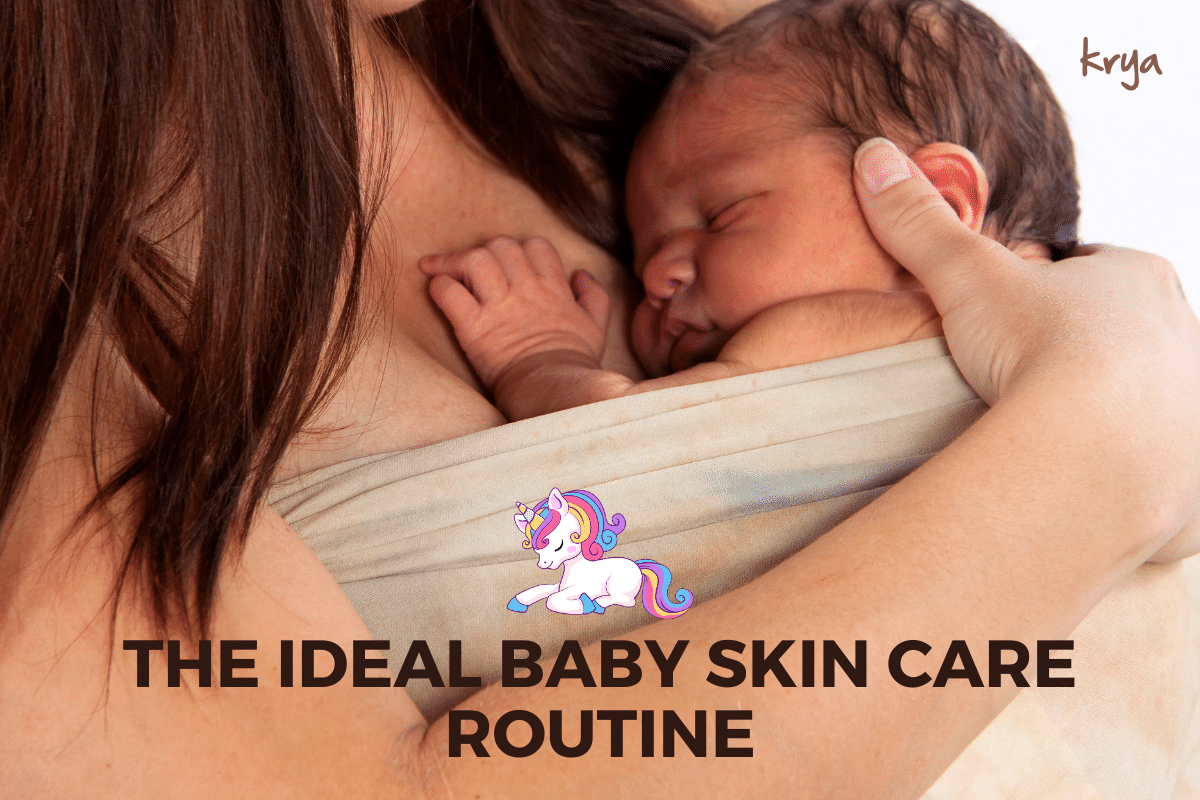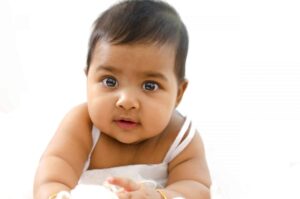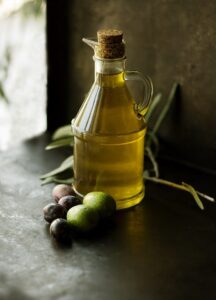A recent verdict by a Missouri based jury left many parents feeling both shocked and angered. This jury passed a verdict asking Johnson & Johnson to pay damages of 72 million dollars to the family of Jacqueline Fox, whose death by ovarian cancer was linked to her daily use (of over 30 years) of Johnsons baby powder and Shower to shower powder.
One of the questions we often get asked at Krya, is about the safety of synthetic baby products and alternatives to these which are completely natural and safe for tender skin.
Human skin is the largest sense organ in our body. It is considered the seat of the indrayas / sense organs and is literally the seat of sight, sense, touch, feeling and hearing. It is our first barrier layer and helps protect our internal organs from damage and bacteria. It is a marvel of bio engineering and hosts a massive colony of micro organisms which work along with us to ensure a constant pH of 5.5, with an acidic mantle that keeps harmful organisms away from us.
The skin and hair structure in children, is one of the last major systems to be formed. This along with the sweating mechanicm is only fully developed when a child reaches the age of three. This makes children’s skin and ahir especially vulnerable and easy to damage, which therefore makes their internal organ systems also easy to damage as their barrier function is still not properly developed.
A study by the campaign for Safe Cosmetics examined baby and children’s products for the presence of 2 probable human carcinogens – 1,4 dioxane and formaldehyde. Both of these are not put in intentionally by manufacturers, but are toxic by products that are formed because of the presence of other chemicals in tehse products. The research study showed that over 61% of the baby products surveyed (across leading brands), contained these 2 chemicals in more than trace quantities.
We are often asked at Krya, what the hidden dangers are in using synthetic baby and child care products. So in this newsletter, we’ve compiled a list of the Suspicious 7 – deadly, carcinogenic and plain irritating ingredients that you would find in your favourite brand of synthetic baby products.
- Talc
Talc is extremely useful to dry out baby’s bottom, but it also often contains asbestos as a contaminant. This is because talc is a mineral that occurs in rock formations – these rock formations are found mixed with other magnesium silicate minerals like asbestos. When mining talc out of the ground, it is extremely difficult to avoid picking up some asbestos as well during the mining process, which is how it comes to contaminate products like baby powders and other cosmetic powders. Asbestos is a probable carcinogen and a lung irritant, and is extremely polluting to the environment as well.
- Fragrances
Fragrances generally made from coal tar and petroleum derivatives, are generally used in the consumer products industry to mask the odour of the other chemicals that are added to the product and to cue a particular scent or emotion among consumers when they use the product: for example, that innocent, sweet smelling “fresh baby” smell that comes from synthetic baby products. The effects of synthetic fragrance are long lasting as they tend to linger on skin for hours and can cause respiratory damage, neurological damage and skin allergies. Growing evidence points to fragrance being an important trigger for childhood asthma as well.
Identifying Fragrance in baby, beauty and household products
Unless the label specifies “un fragranced” or “unscented” or declares 100% of the ingredients without any mention of scents or fragrances, every single baby, beauty and household product contains a synthetic fragrance.
- 1,4-Dioxane and Ethylated surfactants (like SLS, SLeS) – the Environmental Working Group (EWG) found that 57% of baby soaps are contaminated with 1,4-Dioxane. Although it is never listed as an ingredient, 1,4-dioxane is an unwelcome intruder in many beauty products, as it is a toxic by-product that occurs when ethylene oxide is added to the many chemicals in your synthetic baby / beauty product. Ethylene oxide is a known breast carcinogen.
Identifying 1,4-Dioxane & Ethylated surfactants in baby, beauty and household products
Ingredients that contain the letter “eth” indicate the possible presence of 1,4-dioxane – this includes polyethylene, polyethylene glycol, SLS (sodium Laureth sulfate), ceteareth, oleth, oxynol, -xynol, and PEG.
- Proplyene Glycol is a “penetration enhancer” that is added to cleansing and certain moisturizing products to forcibly open the pores of skin and let the chemicals in the products in. This chemical is easily absorbed by skin and may be carcinogenic. Propylene glycol is found in wiper fluid and to remove ice from the windshields and bodies of airplanes after high altitude flying. It is also found in disposable baby wipes. Look out for close cousins Polyethylene Glycol (PEG) and Polypropylene Glycol as well.
Avoid at all costs:
Proplyene Glycol, Polyethylene Glycol (PEG) and Polypropylene Glycol .
- Mineral Oil
Synthetic baby oil is basically a combination of mineral oil, sometimes a scanty amount of hexane extracted vegetable oils and some fragrance thrown in. Mineral oil is a by product of petroleum processing, which I wrote about in detail in my last newsletter. It creates an occlusive barrier on skin , essentially forming the equivalent of plastic cling film on skin, and does not allow skin to interact with the environment or to freely release toxins.
What to look for in your baby / beauty product label:
Masquerades under the innocent sounding mineral oil, white oil, paraffin oil, light liquid paraffin
- We have written before about the 2 deadly Ps on the Krya blog (Parabens and Pthalates) . Parabens are a big family of preservatives found widely in the cosmetic, food and pharmaceutical industries and are the synthetic industry standard for anti bacterial and anti fungal properties. Research from the CDC’s National Centre for Environmental Health found that the blood of over 60% of the children surveyed during the National Health and Nutrition examination survey was contaminated with more than 8 toxins including significant levels of 3 kinds of parabens.
One alarming property of parabens is their ability to enter the body through the skin, something that most people are not aware of. This has been widely studied in underarm cosmetics like deodorants and whiteners. Breast cancer research shows a higher concentration of parabens in the upper lateral breast near the armpit corresponding to the use of deodorants which contain parabens. Globally most governments have not re-examined the safety of parabens. Some outliers are the Danish government which has banned the use of products for children below 3 years. In India parabens are commonly used in cosmetic and other applications.
What to look for in your baby / beauty product label:
Is labeled as ”X-paraben” – for example Methyl Paraben, Ethyl Paraben, Propyl paraben. Also stay away from benzoic acid and Propyl ester.
- Triclosan is an anti-bacterial agent and will find its way into your home in a surprising number of products. Triclosan is an endocrine disruptor and is also being linked to cancer. A new concern is also looming. Due to the uncontrolled use of Triclosan, several strains of bacteria are developing resistance to it causing new “super-bugs”.
Triclosan renders our environment sterile, weakening the development of baby’s natural immunity, increasing the likelihood of allergies and makes anti bacterial treatments less effective when we really need them to work. Is found in anti bacterial soaps, washes, and a whole lot of “sanitized” or “bacteria free” products like toilet seats, baby furniture, wipes, etc
What to look for in your baby / beauty product label:
Is labeled as Triclosan. Suspect any product that claims to be sanitized or “anti bacterial”.
We are going to spend most of May talking about synthetic baby products and talking to you about the healthy natural alternatives to commercial baby products. I hope you found this newsletter informative and thought provoking. See you next week!
Krya now has an authentic, natural baby, toddler and children’s range of skin and hair care products , inspired by the wonderful Indian system of medicine. Krya’s baby range is free from the suspicious Seven and. Does NOT contain mineral oil, SLS, SLeS, Parabens, Preservatives, thickeners, colours, fragrances and anything synthetic.

Here are our current set of baby , toddler and kids products:







Dear Krya
I have used your laundary powder and dish wash powder and am really excited about your products.i really adore your product line which is natural free from harsh chemical .
I am regular follower of your blog .
Kuddooss for such a environmental friendly products
Aarathi – thank you for this very nice comment and your support of what we do!